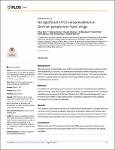No significant HTLV seroprevalence in German people who inject drugs
Hohn, Oliver
Norley, Stephen
Kücherer, Claudia
Bazarbachi, Ali
Hajj, Hiba El
Marcus, Ulrich
Zimmermann, Ruth
Bannert, Norbert
Background: Although human T-lymphotropic virus (HTLV) is transmitted via the same routes as human immunodeficiency virus (HIV), its worldwide seroprevalence differs drastically because HTLV is transmitted mainly via infected cells rather than free virus. The sharing of needles and other equipment places people who inject drugs (PWID) at particularly high-risk for such blood-borne diseases. Methods: To validate the methodology used to process and analyze the dried blood spots (DBS) utilized in the study, dried serum spots (DSS) with dilutions of sera from known HTLV infected individuals were analyzed by ELISA and Western blot. DBS collected between 2011 and 2015 from 2,077 PWID in eight German cities recruited by respondent-driven sampling were tested for HTLV-specific antibodies. Results: The validation demonstrated that the use of DSS allowed identification of samples with even low titers of HTLV-specific antibodies, although a confirmatory Western blot with an additional venous blood sample would often be required. Despite numerous HIV and HCV positive individuals being identified within the study population, none tested positive for HTLV. Conclusion While the HIV and HCV prevalences in German PWID are comparable to those in other European countries, the very low prevalence of HTLV reflects the situation in the general population.
Dateien zu dieser Publikation
Keine Lizenzangabe

